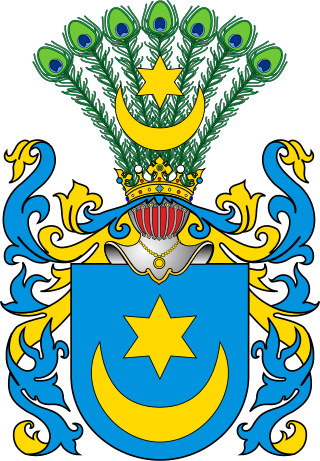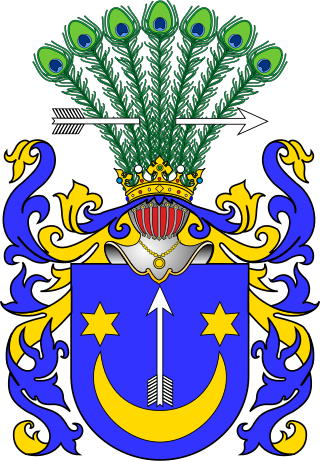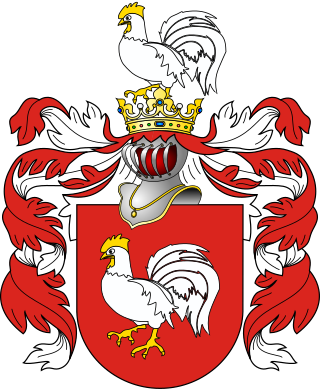
Krynicki (Polish: Kryniccy) is the surname of three Polish noble families of the Sas and Korab coats-of-arms.

Krynicki (Polish: Kryniccy) is the surname of three Polish noble families of the Sas and Korab coats-of-arms.
One Krynicki family of the Sas coat-of-arms is descended from Szandro (Alexander) the Wallachian (Szandro Wołoch) who received the village of Krynica near Lviv (now Stryi Raion, Lviv Oblast) from King Władysław II Jagiełło in 1402. [1] In 1448 King Casimir IV granted knights Daszko (Daniel) and Sienko (Semyon) with the villages of Krynica and Morachwa in Podolia. [1] Their descendants also used the Sas coat-of-arms. [1]

In 1610 a commoner Jan from Krynica was ennobled by King Sigismund III Vasa with the Korab arms for participation in the war against Muscovy. [2] The origins of the Krynickis of the Korab arms are uncertain. It is believed that Jan Krynicki originated in Krynica-Zdrój. [3] There is a hypothesis that Jan Krynicki was the son of Danko from Miastko (the current village of Tylicz), the first soltys of Krynica, a rich peasant from Wallachia. [4] Nevertheless, Jerzy Krynicki believes he was a burgher. [5] However, Tadeusz M.Trajdos argues there is no certainty as to where Jan Krynicki actually came from. [6] The debate over Jan Krynicki's background is complicated by the fact that in the patent it says his mother hailed from an old Polish noble family, thus a marriage choice for a commoner is questioned. [5] Z. Wąsowicz believes Danko from Miastko was a Polish Catholic instead. [5] Tadeusz Trajdos also points out that there is no record of Jan Krynicki's possible offspring and, thus, no documented connection with the Krynickis who used the Korab coat-of-arms in the 18th century. [7]

Korczak is a Polish coat of arms. It was used by several noble families of Clan Korczak in the times of the Kingdom of Poland and the Polish–Lithuanian Commonwealth.

Leliwa is a Polish coat of arms. It was used by several hundred szlachta families during the existence of the Kingdom of Poland and the Polish–Lithuanian Commonwealth, and remains in use today by many of the descendants of these families. There are several forms of the arms, all of which bear the name, Leliwa, but which may be distinguished as variations of the same arms by the addition of a Roman numeral. In 19th century during a pan South-Slavic Illyrian movement heraldic term Leliwa also entered Croatian heraldry as a name for the coat of arms considered to be the oldest known symbol; Bleu celeste, a mullet of six points Or surmounted above a crescent Argent – A golden six-pointed star over a silver crescent moon on a blue shield, but also as a name for all other coats of arms that have a crescent and a mullet.

Ciołek is a Polish coat of arms, one of the oldest in medieval Poland. It was used by many szlachta (noble) families under the late Piast dynasty, under the Polish–Lithuanian Commonwealth, during the Partitions of Poland, and in the 20th century. The variant names "Siolek" and "Cialek" arose from miscommunication among early-20th-century Polish immigrants to the United States.

Poraj is a Polish Coat of Arms. Used by several knighthood families of medieval Poland and noble families of the Polish–Lithuanian Commonwealth - those descended in the male-line from the Poraj family and those allowed into the heraldic clan by adoption.

Topór is a Polish coat of arms. It was used by several szlachta (noble) families in medieval Poland and under the Polish–Lithuanian Commonwealth.

Polish heraldry is the study of the coats of arms that have historically been used in Poland and the Polish–Lithuanian Commonwealth. It treats of specifically Polish heraldic traits and of the Polish heraldic system, contrasted with heraldic systems used elsewhere, notably in Western Europe. Due to the distinctive ways in which feudal societies evolved, Poland's heraldic traditions differ substantially from those of the modern-day German lands and France.

Korab is a Polish coat of arms. It was used by many szlachta (noble) families under the Kingdom of Poland and the Polish–Lithuanian Commonwealth.

Sas or Szász is a Central European coat of arms. It was borne since the medieval period by several Transylvanian-Saxon Hungarian, Ruthenian, Ukrainian, and Polish-Lithuanian noble families. The house was once a mighty princely and ducal house with origins in Saxony, Transylvania, Hungary and Ruthenia.

Mikołaj Rej or Mikołaj Rey of Nagłowice was a Polish poet and prose writer of the emerging Renaissance in Poland as it succeeded the Middle Ages, as well as a politician and musician. He was the first Polish author to write exclusively in the Polish language, and is considered, to be one of the founders of Polish literary language and literature.

Kur is a Polish coat of arms. It was used by several noble families forming a Clan of Kur in the times of the Kingdom of Poland and the Polish–Lithuanian Commonwealth. It is noted during the reign of the Jagiellon dynasty and illustrated with its original name in the work of Bartosz Paprocki "Herby Rycerstwa Polskiego" in 1584. Furthermore, it is published in the work of Szymon Okolski in 1641. and several other publications
Polish heraldry is typical to the Polish nobility/szlachta, which has its origins in Middle Ages knights/warriors clans that provided military support to the king, dukes or overlords.

The House of Mniszech was a Polish magnate and noble family bearing the Mniszech Coat of Arms.

The House of Dzieduszycki is an old Polish noble family first recorded in 1400. Members of the family held the title of Count, awarded to them on 22 October 1776. The title was heritable by all legitimate male-line descendants.

The Kobyzewicz family was a boyar family of the Grand Duchy of Lithuania in the 16th—17th centuries. The family's cadet branch, Kobyzewicz-Krynicki, received the status of the Polish szlachta. The family was known for their active role in the history of Kyiv. The Kobyzewicz family is claimed to be paternal to the Lyzohub family of the Cossack Hetmanate.

Clan Ostoja (Moscics) is one of the largest and oldest knightly and heraldic families in Europe, belonging to the Polish nobility. The family is sealed with the Ostoja coat of arms.

The Scibor-Bogusławski family – a Polish noble family with the coat of arms of Ostoja, belonging to the heraldic Clan Ostoje (Moscics), originating from Bogusławice in the former Sieradz Province, Radomsko County.

The Błociszewski family - a Polish noble family with the coat of arms of Ostoja, belonging to the heraldic Clan Ostoja (Moscics), originating from Błociszewo in the former of Kościan district of Poznań voivodeship. From the Błociszewskis of the Ostoja CoA come: Brodnicki, Bytkowski, Gajewski, Lubiatowski, Ptaszkowski, Szczodrowki.